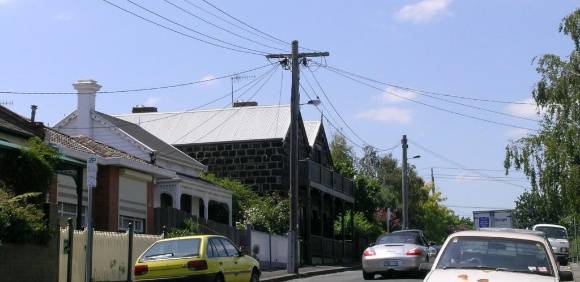| Back to search results » | Back to search page » |
|
Barkly Gardens Precinct, Richmond
Other NameBarkly Gardens Precinct, Richmond LocationRICHMOND, YARRA CITY LevelIncluded in Heritage Overlay |
|
Statement of Significance
What is significant? - The buildings constructed from c.1855 to c.1925, as shown on the precinct map. The following buildings are Individually Significant to the precinct: 49-55 and 167 Brighton Street; 2 Burgess Street; 235 & 245 Coppin Street; 11-15, 14 & 22 James Street; 24, 28 & 30 Lesney Street; 230 & 240 Mary Street; 2, 7 & 11 Rose Street; as well as HO231 - 30 Brighton Street, HO232 - 164-166 Brighton Street, and HO273 - 36 Lesney Street. Non-original alterations and additions to the Contributory or Individually Significant buildings shown on the precinct map, post-World War II plantings and buildings in Barkly Gardens, and other post-World War II houses and buildings are not significant. How it is significant? Why it is significant? The precinct is significant as an enclave that is characteristic of the residential areas in Richmond that largely developed prior to World War II and comprise predominantly Victorian era housing, supplemented by Edwardian and interwar infill, which is complemented by traditional streetscape materials such as asphalt footpaths, bluestone kerb and channel and bluestone laneways. Overall, the intactness of the building stock to the period prior to World War II is very high. (Criterion D) The precinct also demonstrates other characteristics of nineteenth century subdivisions such as regular allotment pattern served by rear laneways. The distinctive pattern of rear laneways, some of generous width, in the section west of Barkly Gardens that was part of the c.1853 subdivision is of particular note. The development of Barkly Gardens as a central garden square (it was originally known as Barkly Square), which is flanked on two sides by housing follows English traditions of residential garden square planning is also of note as the only example of this type in Richmond. (Criterion D) Barkly Gardens (originally known as Barkly Square) has aesthetic importance as a traditional nineteenth century English garden square, which enhances the setting of the houses in the adjoining street, which in Coppin Street were designed to face toward the square and have generous garden setbacks that enhance the visual connection. Barkly Gardens is also socially significant as a park that has been enjoyed by the local community for over 140 years. (Criteria E & G)
The Barkly Gardens precinct, comprising 21-41 & 20-36 Amsterdam St, 1 & 5-17 Barkly Ave, 17-69, 79-83, 101-167 & 28, 30, 38-86, 114-148, 154, 164-186 Brighton St, 2-22 Burgess St, 227-283 Coppin St, 3-41 & 4-38 Cotter St, 1 & 3 Durham St, 9-11 Goodwin St, 3-17 & 4-22 James St, 12-36 Lesney St, 1-15 Madden Gve, 208-242, 248-254 & 266-320 Mary St, 2-18 & 40-60 Rooney St, 3-11, 4-12 & 16 Rose St, 1-11 Shamrock St and 14-18 & 25-45 Yorkshire St and Barkly Gardens reserve is significant. The following buildings and features contribute to the significance of the precinct:
- The overall consistency of building forms (pitched gabled or hipped roofs, one storey wall heights with a smaller amount of two storey dwellings), materials and detailing (walls of weatherboard or face brick or stucco, prominent brick or render chimneys, post-supported verandahs facing the street), and siting (small or no front and side setbacks).
- The nineteenth/early twentieth form and layout of the Barkly Gardens and the surviving mature plantings of Oaks (Quercus sp.) and Peppers (Schinus molle).
- The nineteenth century subdivision pattern comprising regular allotments served by rear bluestone laneways.
- Traditional streetscape materials such as asphalt pathways and bluestone kerb and channel.
The Barkly Gardens precinct is of local historic and aesthetic significance to the City of Yarra.
The precinct is historically significant as tangible evidence of important phases in the residential development of Richmond from the mid-nineteenth century to the interwar period from the earliest settlement through the late Victorian boom, and to the final phase of recovery and infill development during the early twentieth century. The presence of some former shops and a hotel demonstrates how local neighbourhoods were self-contained with commercial and social amenities usually within walking distance. The significance of the precinct is enhanced by the presence of rare early houses, including some that date prior to 1855, which are clustered in and around Lesney, James and Mary streets. It is also notable for the very narrow streets or laneways containing small cottages, once relatively common but now increasingly rare in Richmond. (Criteria A & B)
Group
Residential buildings (private)
Category
Residential Precinct




